Strategic Management and Sustainability of EasyJet
VerifiedAdded on 2023/05/29
|14
|3662
|429
AI Summary
This study material discusses the strategic management and sustainability of EasyJet. It includes a PESTEL analysis, Porter's five forces framework, SWOT analysis, strategic capability mapping, VRIO framework, recommended strategies and more. The study material is relevant for courses in strategic management and sustainability.
Contribute Materials
Your contribution can guide someone’s learning journey. Share your
documents today.
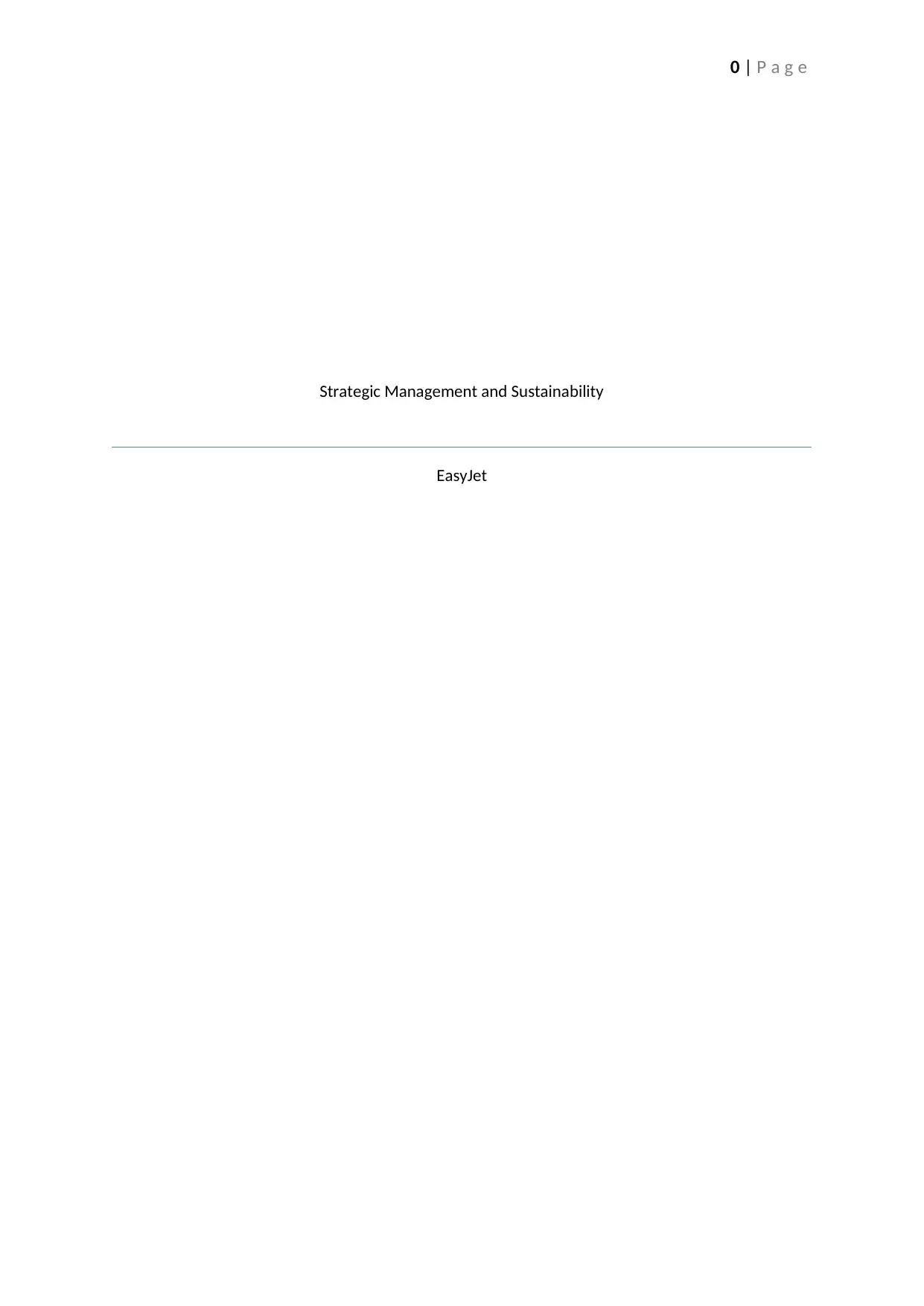
0 | P a g e
Strategic Management and Sustainability
EasyJet
Strategic Management and Sustainability
EasyJet
Secure Best Marks with AI Grader
Need help grading? Try our AI Grader for instant feedback on your assignments.

1 | P a g e
Table of Contents
Introduction...............................................................................................................................2
EasyJet Airline............................................................................................................................2
PESTEL Analysis of EasyJet.........................................................................................................3
Porter’s five forces framework..................................................................................................4
SWOT Analysis............................................................................................................................6
Strategic Capability Mapping.....................................................................................................7
VRIO Framework........................................................................................................................7
Recommended strategies..........................................................................................................8
SFA Analysis................................................................................................................................9
Key findings..............................................................................................................................10
Conclusion................................................................................................................................10
References................................................................................................................................11
Table of figures
Figure 1: EasyJet Price Advantage..............................................................................................3
Table of Contents
Introduction...............................................................................................................................2
EasyJet Airline............................................................................................................................2
PESTEL Analysis of EasyJet.........................................................................................................3
Porter’s five forces framework..................................................................................................4
SWOT Analysis............................................................................................................................6
Strategic Capability Mapping.....................................................................................................7
VRIO Framework........................................................................................................................7
Recommended strategies..........................................................................................................8
SFA Analysis................................................................................................................................9
Key findings..............................................................................................................................10
Conclusion................................................................................................................................10
References................................................................................................................................11
Table of figures
Figure 1: EasyJet Price Advantage..............................................................................................3
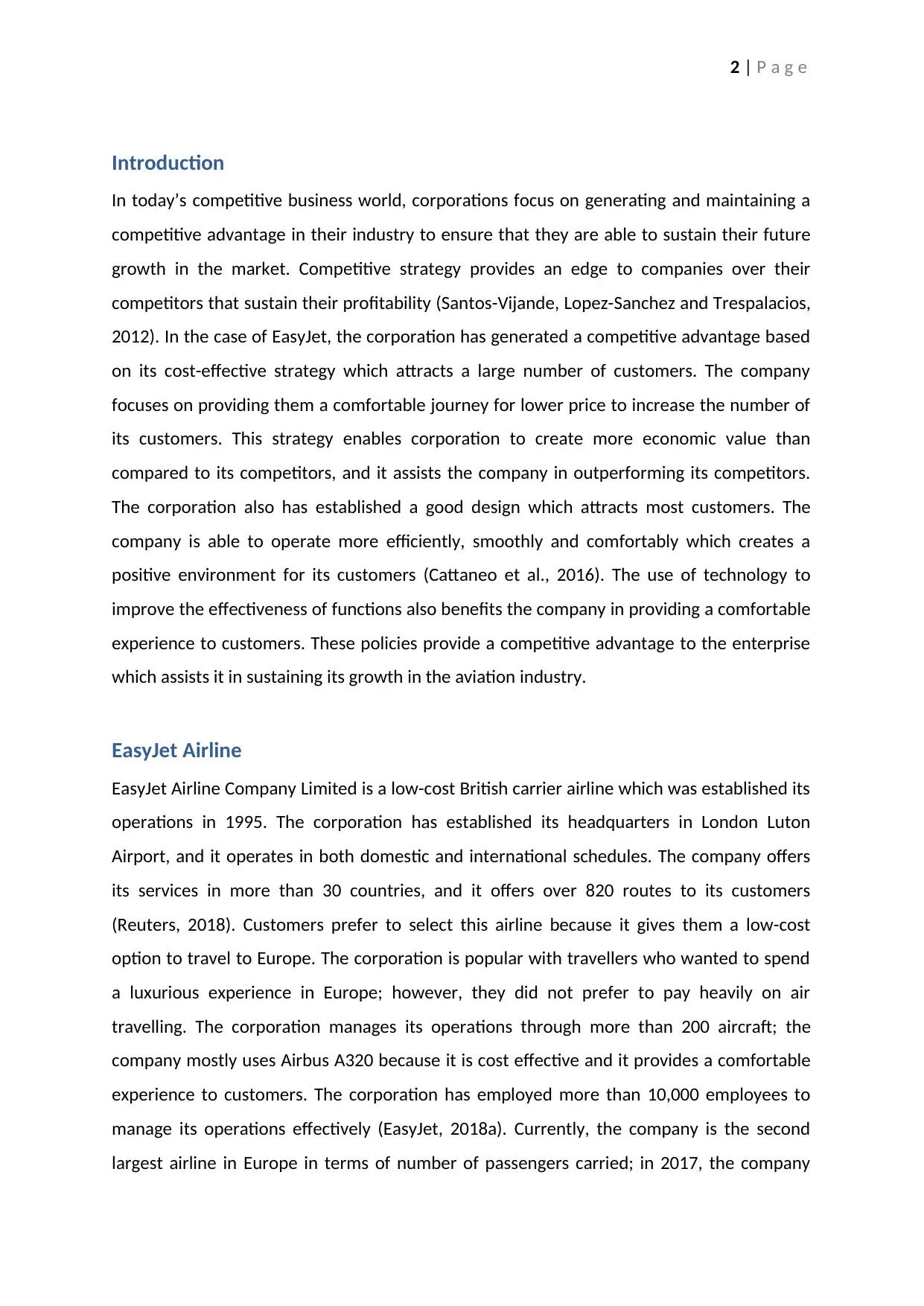
2 | P a g e
Introduction
In today’s competitive business world, corporations focus on generating and maintaining a
competitive advantage in their industry to ensure that they are able to sustain their future
growth in the market. Competitive strategy provides an edge to companies over their
competitors that sustain their profitability (Santos-Vijande, Lopez-Sanchez and Trespalacios,
2012). In the case of EasyJet, the corporation has generated a competitive advantage based
on its cost-effective strategy which attracts a large number of customers. The company
focuses on providing them a comfortable journey for lower price to increase the number of
its customers. This strategy enables corporation to create more economic value than
compared to its competitors, and it assists the company in outperforming its competitors.
The corporation also has established a good design which attracts most customers. The
company is able to operate more efficiently, smoothly and comfortably which creates a
positive environment for its customers (Cattaneo et al., 2016). The use of technology to
improve the effectiveness of functions also benefits the company in providing a comfortable
experience to customers. These policies provide a competitive advantage to the enterprise
which assists it in sustaining its growth in the aviation industry.
EasyJet Airline
EasyJet Airline Company Limited is a low-cost British carrier airline which was established its
operations in 1995. The corporation has established its headquarters in London Luton
Airport, and it operates in both domestic and international schedules. The company offers
its services in more than 30 countries, and it offers over 820 routes to its customers
(Reuters, 2018). Customers prefer to select this airline because it gives them a low-cost
option to travel to Europe. The corporation is popular with travellers who wanted to spend
a luxurious experience in Europe; however, they did not prefer to pay heavily on air
travelling. The corporation manages its operations through more than 200 aircraft; the
company mostly uses Airbus A320 because it is cost effective and it provides a comfortable
experience to customers. The corporation has employed more than 10,000 employees to
manage its operations effectively (EasyJet, 2018a). Currently, the company is the second
largest airline in Europe in terms of number of passengers carried; in 2017, the company
Introduction
In today’s competitive business world, corporations focus on generating and maintaining a
competitive advantage in their industry to ensure that they are able to sustain their future
growth in the market. Competitive strategy provides an edge to companies over their
competitors that sustain their profitability (Santos-Vijande, Lopez-Sanchez and Trespalacios,
2012). In the case of EasyJet, the corporation has generated a competitive advantage based
on its cost-effective strategy which attracts a large number of customers. The company
focuses on providing them a comfortable journey for lower price to increase the number of
its customers. This strategy enables corporation to create more economic value than
compared to its competitors, and it assists the company in outperforming its competitors.
The corporation also has established a good design which attracts most customers. The
company is able to operate more efficiently, smoothly and comfortably which creates a
positive environment for its customers (Cattaneo et al., 2016). The use of technology to
improve the effectiveness of functions also benefits the company in providing a comfortable
experience to customers. These policies provide a competitive advantage to the enterprise
which assists it in sustaining its growth in the aviation industry.
EasyJet Airline
EasyJet Airline Company Limited is a low-cost British carrier airline which was established its
operations in 1995. The corporation has established its headquarters in London Luton
Airport, and it operates in both domestic and international schedules. The company offers
its services in more than 30 countries, and it offers over 820 routes to its customers
(Reuters, 2018). Customers prefer to select this airline because it gives them a low-cost
option to travel to Europe. The corporation is popular with travellers who wanted to spend
a luxurious experience in Europe; however, they did not prefer to pay heavily on air
travelling. The corporation manages its operations through more than 200 aircraft; the
company mostly uses Airbus A320 because it is cost effective and it provides a comfortable
experience to customers. The corporation has employed more than 10,000 employees to
manage its operations effectively (EasyJet, 2018a). Currently, the company is the second
largest airline in Europe in terms of number of passengers carried; in 2017, the company
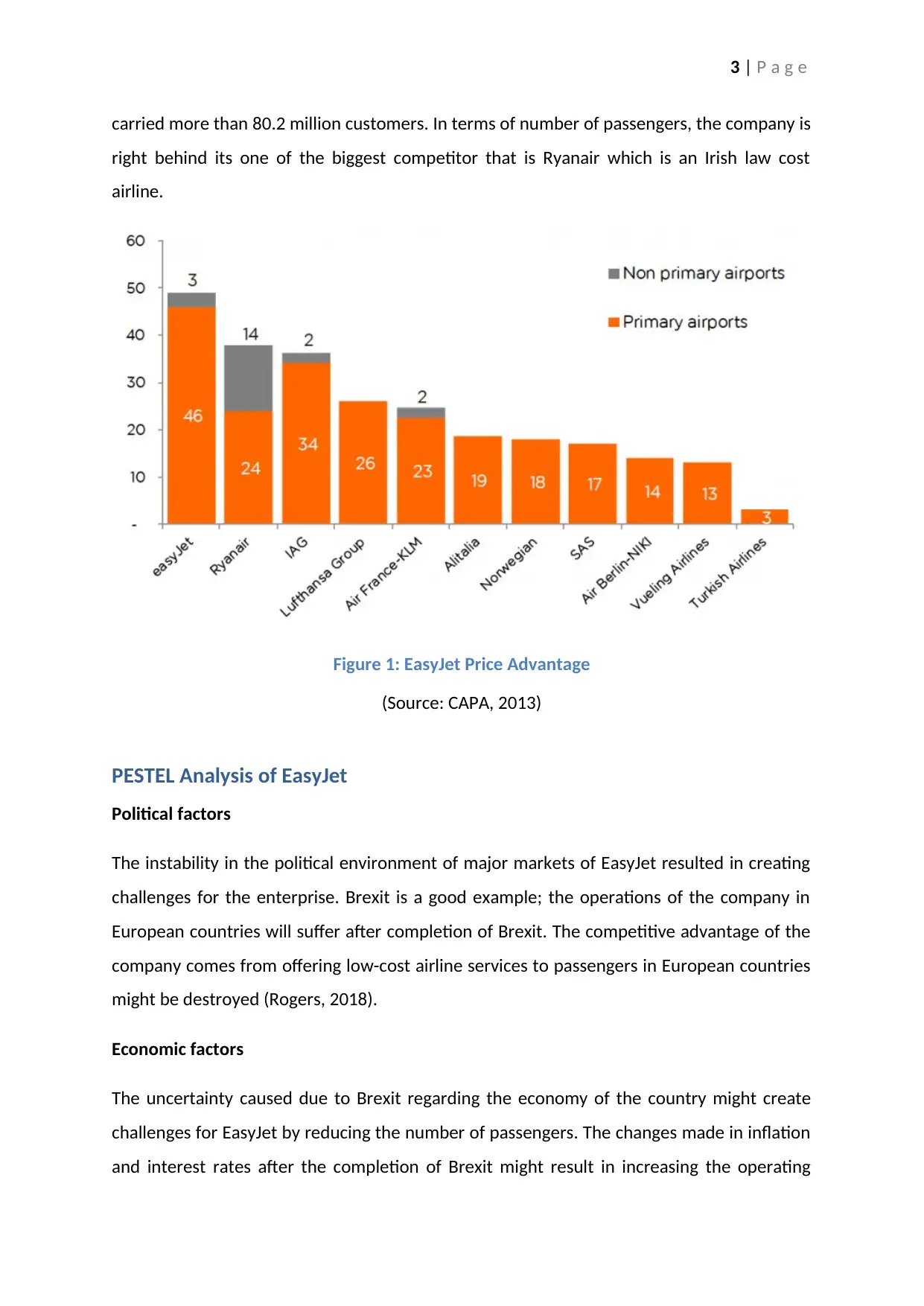
3 | P a g e
carried more than 80.2 million customers. In terms of number of passengers, the company is
right behind its one of the biggest competitor that is Ryanair which is an Irish law cost
airline.
Figure 1: EasyJet Price Advantage
(Source: CAPA, 2013)
PESTEL Analysis of EasyJet
Political factors
The instability in the political environment of major markets of EasyJet resulted in creating
challenges for the enterprise. Brexit is a good example; the operations of the company in
European countries will suffer after completion of Brexit. The competitive advantage of the
company comes from offering low-cost airline services to passengers in European countries
might be destroyed (Rogers, 2018).
Economic factors
The uncertainty caused due to Brexit regarding the economy of the country might create
challenges for EasyJet by reducing the number of passengers. The changes made in inflation
and interest rates after the completion of Brexit might result in increasing the operating
carried more than 80.2 million customers. In terms of number of passengers, the company is
right behind its one of the biggest competitor that is Ryanair which is an Irish law cost
airline.
Figure 1: EasyJet Price Advantage
(Source: CAPA, 2013)
PESTEL Analysis of EasyJet
Political factors
The instability in the political environment of major markets of EasyJet resulted in creating
challenges for the enterprise. Brexit is a good example; the operations of the company in
European countries will suffer after completion of Brexit. The competitive advantage of the
company comes from offering low-cost airline services to passengers in European countries
might be destroyed (Rogers, 2018).
Economic factors
The uncertainty caused due to Brexit regarding the economy of the country might create
challenges for EasyJet by reducing the number of passengers. The changes made in inflation
and interest rates after the completion of Brexit might result in increasing the operating
Secure Best Marks with AI Grader
Need help grading? Try our AI Grader for instant feedback on your assignments.
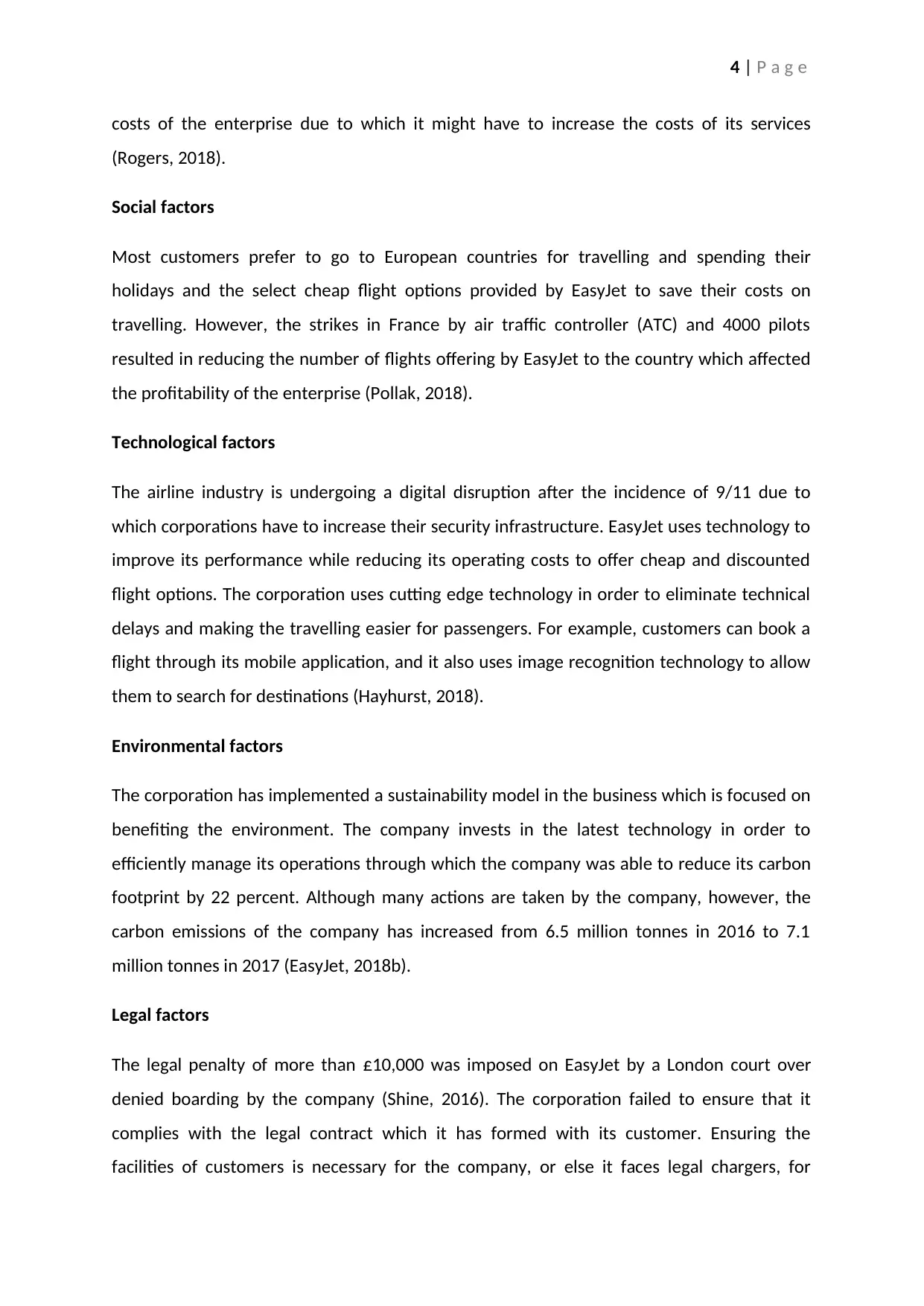
4 | P a g e
costs of the enterprise due to which it might have to increase the costs of its services
(Rogers, 2018).
Social factors
Most customers prefer to go to European countries for travelling and spending their
holidays and the select cheap flight options provided by EasyJet to save their costs on
travelling. However, the strikes in France by air traffic controller (ATC) and 4000 pilots
resulted in reducing the number of flights offering by EasyJet to the country which affected
the profitability of the enterprise (Pollak, 2018).
Technological factors
The airline industry is undergoing a digital disruption after the incidence of 9/11 due to
which corporations have to increase their security infrastructure. EasyJet uses technology to
improve its performance while reducing its operating costs to offer cheap and discounted
flight options. The corporation uses cutting edge technology in order to eliminate technical
delays and making the travelling easier for passengers. For example, customers can book a
flight through its mobile application, and it also uses image recognition technology to allow
them to search for destinations (Hayhurst, 2018).
Environmental factors
The corporation has implemented a sustainability model in the business which is focused on
benefiting the environment. The company invests in the latest technology in order to
efficiently manage its operations through which the company was able to reduce its carbon
footprint by 22 percent. Although many actions are taken by the company, however, the
carbon emissions of the company has increased from 6.5 million tonnes in 2016 to 7.1
million tonnes in 2017 (EasyJet, 2018b).
Legal factors
The legal penalty of more than £10,000 was imposed on EasyJet by a London court over
denied boarding by the company (Shine, 2016). The corporation failed to ensure that it
complies with the legal contract which it has formed with its customer. Ensuring the
facilities of customers is necessary for the company, or else it faces legal chargers, for
costs of the enterprise due to which it might have to increase the costs of its services
(Rogers, 2018).
Social factors
Most customers prefer to go to European countries for travelling and spending their
holidays and the select cheap flight options provided by EasyJet to save their costs on
travelling. However, the strikes in France by air traffic controller (ATC) and 4000 pilots
resulted in reducing the number of flights offering by EasyJet to the country which affected
the profitability of the enterprise (Pollak, 2018).
Technological factors
The airline industry is undergoing a digital disruption after the incidence of 9/11 due to
which corporations have to increase their security infrastructure. EasyJet uses technology to
improve its performance while reducing its operating costs to offer cheap and discounted
flight options. The corporation uses cutting edge technology in order to eliminate technical
delays and making the travelling easier for passengers. For example, customers can book a
flight through its mobile application, and it also uses image recognition technology to allow
them to search for destinations (Hayhurst, 2018).
Environmental factors
The corporation has implemented a sustainability model in the business which is focused on
benefiting the environment. The company invests in the latest technology in order to
efficiently manage its operations through which the company was able to reduce its carbon
footprint by 22 percent. Although many actions are taken by the company, however, the
carbon emissions of the company has increased from 6.5 million tonnes in 2016 to 7.1
million tonnes in 2017 (EasyJet, 2018b).
Legal factors
The legal penalty of more than £10,000 was imposed on EasyJet by a London court over
denied boarding by the company (Shine, 2016). The corporation failed to ensure that it
complies with the legal contract which it has formed with its customer. Ensuring the
facilities of customers is necessary for the company, or else it faces legal chargers, for
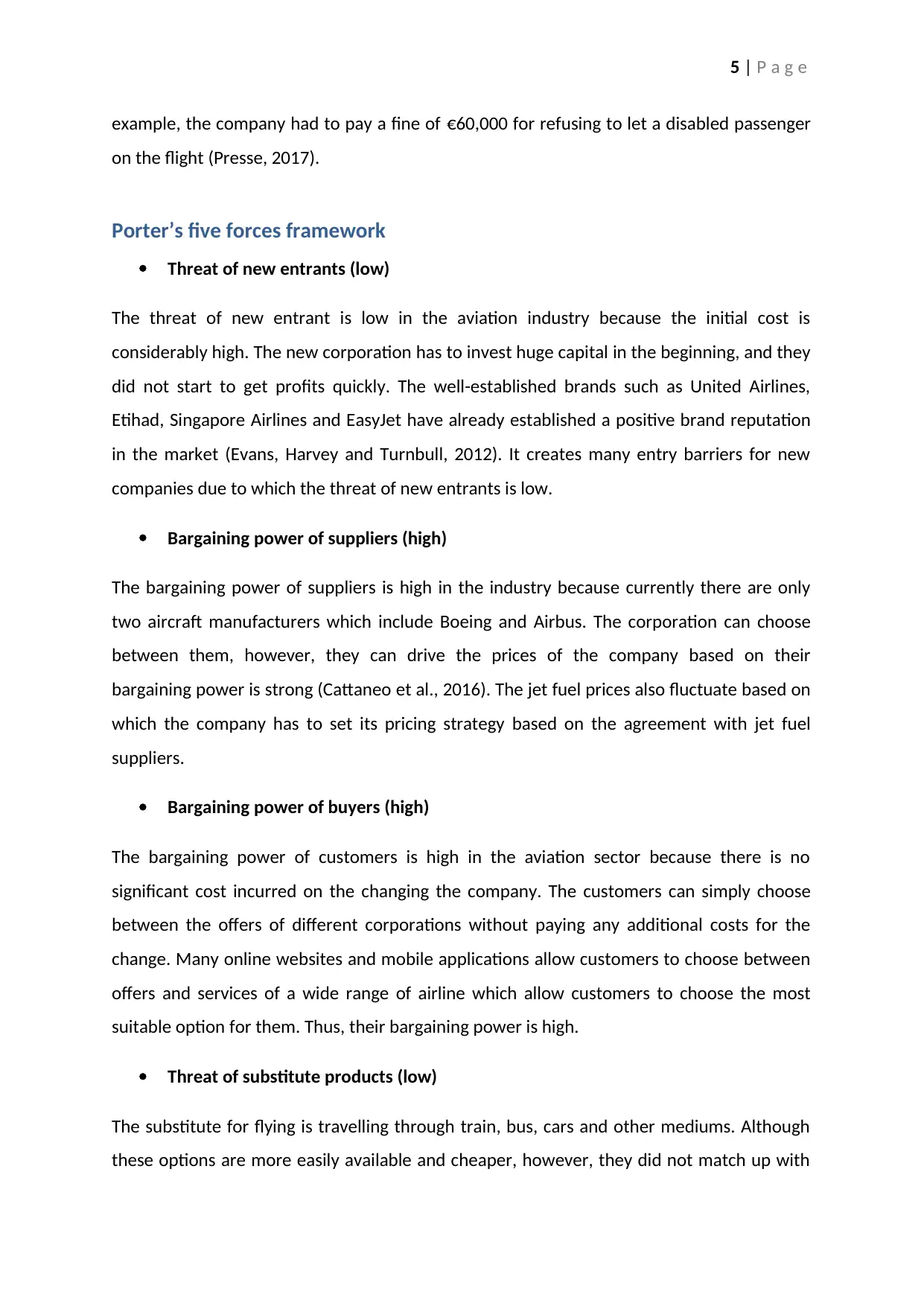
5 | P a g e
example, the company had to pay a fine of €60,000 for refusing to let a disabled passenger
on the flight (Presse, 2017).
Porter’s five forces framework
Threat of new entrants (low)
The threat of new entrant is low in the aviation industry because the initial cost is
considerably high. The new corporation has to invest huge capital in the beginning, and they
did not start to get profits quickly. The well-established brands such as United Airlines,
Etihad, Singapore Airlines and EasyJet have already established a positive brand reputation
in the market (Evans, Harvey and Turnbull, 2012). It creates many entry barriers for new
companies due to which the threat of new entrants is low.
Bargaining power of suppliers (high)
The bargaining power of suppliers is high in the industry because currently there are only
two aircraft manufacturers which include Boeing and Airbus. The corporation can choose
between them, however, they can drive the prices of the company based on their
bargaining power is strong (Cattaneo et al., 2016). The jet fuel prices also fluctuate based on
which the company has to set its pricing strategy based on the agreement with jet fuel
suppliers.
Bargaining power of buyers (high)
The bargaining power of customers is high in the aviation sector because there is no
significant cost incurred on the changing the company. The customers can simply choose
between the offers of different corporations without paying any additional costs for the
change. Many online websites and mobile applications allow customers to choose between
offers and services of a wide range of airline which allow customers to choose the most
suitable option for them. Thus, their bargaining power is high.
Threat of substitute products (low)
The substitute for flying is travelling through train, bus, cars and other mediums. Although
these options are more easily available and cheaper, however, they did not match up with
example, the company had to pay a fine of €60,000 for refusing to let a disabled passenger
on the flight (Presse, 2017).
Porter’s five forces framework
Threat of new entrants (low)
The threat of new entrant is low in the aviation industry because the initial cost is
considerably high. The new corporation has to invest huge capital in the beginning, and they
did not start to get profits quickly. The well-established brands such as United Airlines,
Etihad, Singapore Airlines and EasyJet have already established a positive brand reputation
in the market (Evans, Harvey and Turnbull, 2012). It creates many entry barriers for new
companies due to which the threat of new entrants is low.
Bargaining power of suppliers (high)
The bargaining power of suppliers is high in the industry because currently there are only
two aircraft manufacturers which include Boeing and Airbus. The corporation can choose
between them, however, they can drive the prices of the company based on their
bargaining power is strong (Cattaneo et al., 2016). The jet fuel prices also fluctuate based on
which the company has to set its pricing strategy based on the agreement with jet fuel
suppliers.
Bargaining power of buyers (high)
The bargaining power of customers is high in the aviation sector because there is no
significant cost incurred on the changing the company. The customers can simply choose
between the offers of different corporations without paying any additional costs for the
change. Many online websites and mobile applications allow customers to choose between
offers and services of a wide range of airline which allow customers to choose the most
suitable option for them. Thus, their bargaining power is high.
Threat of substitute products (low)
The substitute for flying is travelling through train, bus, cars and other mediums. Although
these options are more easily available and cheaper, however, they did not match up with
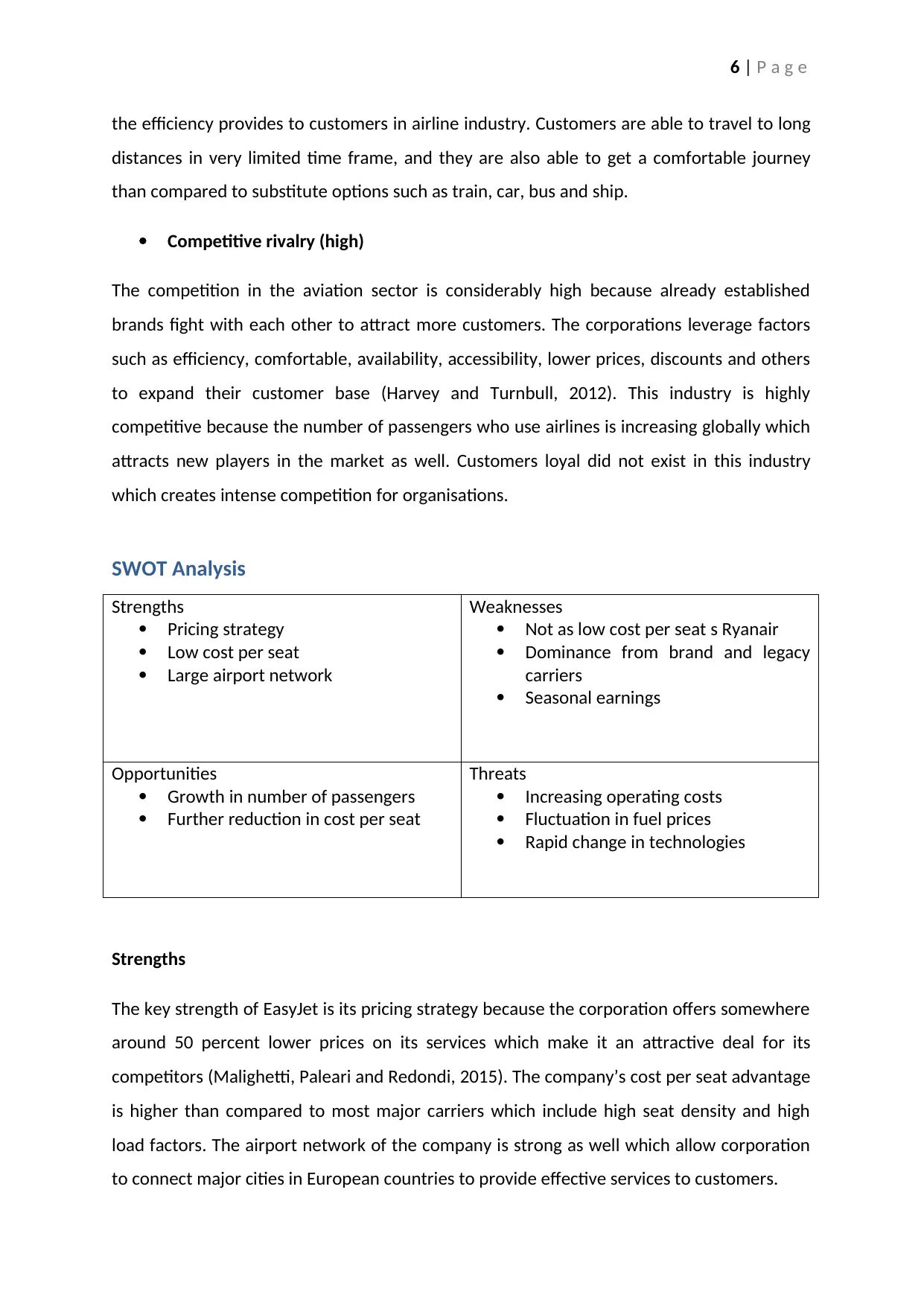
6 | P a g e
the efficiency provides to customers in airline industry. Customers are able to travel to long
distances in very limited time frame, and they are also able to get a comfortable journey
than compared to substitute options such as train, car, bus and ship.
Competitive rivalry (high)
The competition in the aviation sector is considerably high because already established
brands fight with each other to attract more customers. The corporations leverage factors
such as efficiency, comfortable, availability, accessibility, lower prices, discounts and others
to expand their customer base (Harvey and Turnbull, 2012). This industry is highly
competitive because the number of passengers who use airlines is increasing globally which
attracts new players in the market as well. Customers loyal did not exist in this industry
which creates intense competition for organisations.
SWOT Analysis
Strengths
Pricing strategy
Low cost per seat
Large airport network
Weaknesses
Not as low cost per seat s Ryanair
Dominance from brand and legacy
carriers
Seasonal earnings
Opportunities
Growth in number of passengers
Further reduction in cost per seat
Threats
Increasing operating costs
Fluctuation in fuel prices
Rapid change in technologies
Strengths
The key strength of EasyJet is its pricing strategy because the corporation offers somewhere
around 50 percent lower prices on its services which make it an attractive deal for its
competitors (Malighetti, Paleari and Redondi, 2015). The company’s cost per seat advantage
is higher than compared to most major carriers which include high seat density and high
load factors. The airport network of the company is strong as well which allow corporation
to connect major cities in European countries to provide effective services to customers.
the efficiency provides to customers in airline industry. Customers are able to travel to long
distances in very limited time frame, and they are also able to get a comfortable journey
than compared to substitute options such as train, car, bus and ship.
Competitive rivalry (high)
The competition in the aviation sector is considerably high because already established
brands fight with each other to attract more customers. The corporations leverage factors
such as efficiency, comfortable, availability, accessibility, lower prices, discounts and others
to expand their customer base (Harvey and Turnbull, 2012). This industry is highly
competitive because the number of passengers who use airlines is increasing globally which
attracts new players in the market as well. Customers loyal did not exist in this industry
which creates intense competition for organisations.
SWOT Analysis
Strengths
Pricing strategy
Low cost per seat
Large airport network
Weaknesses
Not as low cost per seat s Ryanair
Dominance from brand and legacy
carriers
Seasonal earnings
Opportunities
Growth in number of passengers
Further reduction in cost per seat
Threats
Increasing operating costs
Fluctuation in fuel prices
Rapid change in technologies
Strengths
The key strength of EasyJet is its pricing strategy because the corporation offers somewhere
around 50 percent lower prices on its services which make it an attractive deal for its
competitors (Malighetti, Paleari and Redondi, 2015). The company’s cost per seat advantage
is higher than compared to most major carriers which include high seat density and high
load factors. The airport network of the company is strong as well which allow corporation
to connect major cities in European countries to provide effective services to customers.
Paraphrase This Document
Need a fresh take? Get an instant paraphrase of this document with our AI Paraphraser
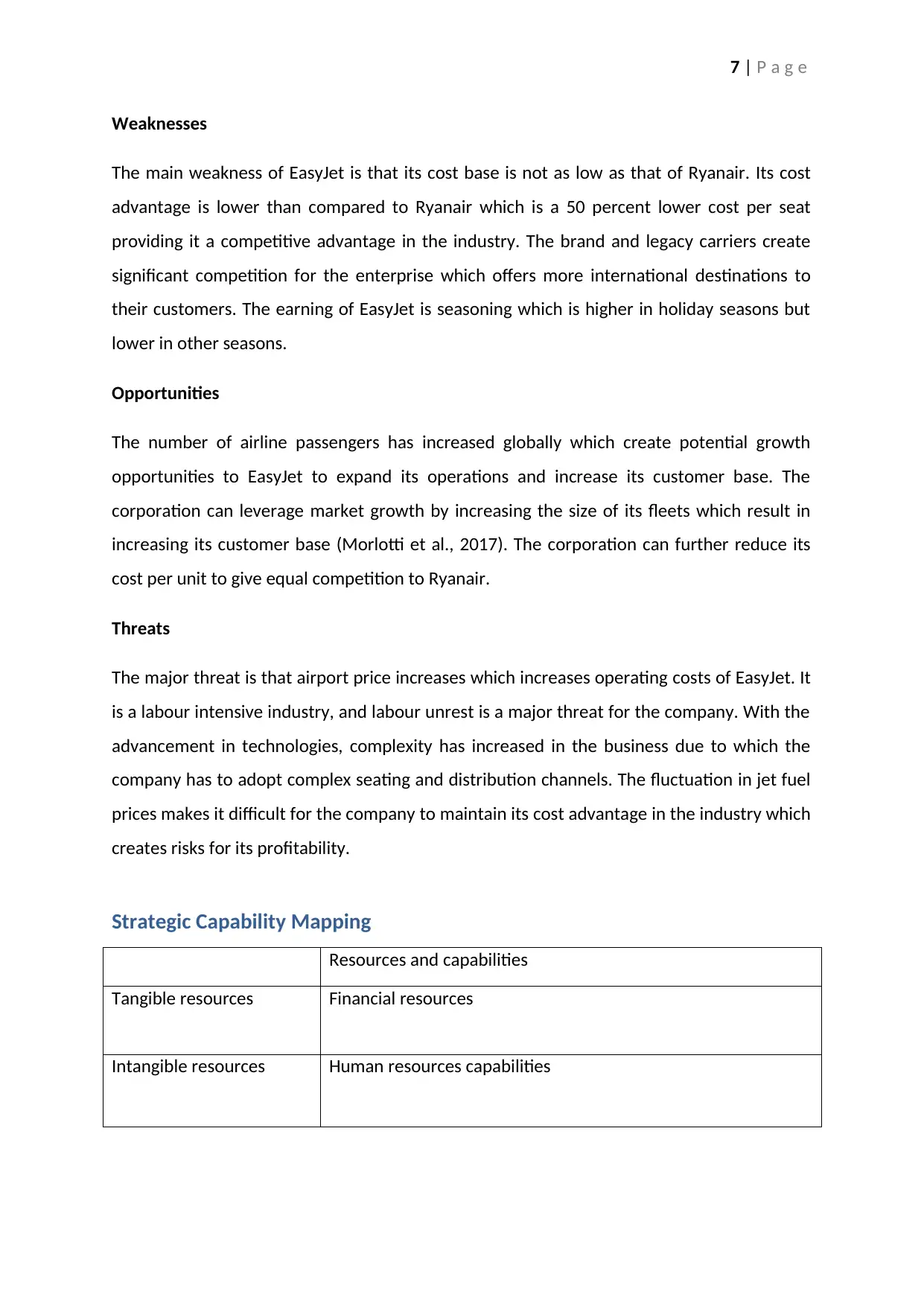
7 | P a g e
Weaknesses
The main weakness of EasyJet is that its cost base is not as low as that of Ryanair. Its cost
advantage is lower than compared to Ryanair which is a 50 percent lower cost per seat
providing it a competitive advantage in the industry. The brand and legacy carriers create
significant competition for the enterprise which offers more international destinations to
their customers. The earning of EasyJet is seasoning which is higher in holiday seasons but
lower in other seasons.
Opportunities
The number of airline passengers has increased globally which create potential growth
opportunities to EasyJet to expand its operations and increase its customer base. The
corporation can leverage market growth by increasing the size of its fleets which result in
increasing its customer base (Morlotti et al., 2017). The corporation can further reduce its
cost per unit to give equal competition to Ryanair.
Threats
The major threat is that airport price increases which increases operating costs of EasyJet. It
is a labour intensive industry, and labour unrest is a major threat for the company. With the
advancement in technologies, complexity has increased in the business due to which the
company has to adopt complex seating and distribution channels. The fluctuation in jet fuel
prices makes it difficult for the company to maintain its cost advantage in the industry which
creates risks for its profitability.
Strategic Capability Mapping
Resources and capabilities
Tangible resources Financial resources
Intangible resources Human resources capabilities
Weaknesses
The main weakness of EasyJet is that its cost base is not as low as that of Ryanair. Its cost
advantage is lower than compared to Ryanair which is a 50 percent lower cost per seat
providing it a competitive advantage in the industry. The brand and legacy carriers create
significant competition for the enterprise which offers more international destinations to
their customers. The earning of EasyJet is seasoning which is higher in holiday seasons but
lower in other seasons.
Opportunities
The number of airline passengers has increased globally which create potential growth
opportunities to EasyJet to expand its operations and increase its customer base. The
corporation can leverage market growth by increasing the size of its fleets which result in
increasing its customer base (Morlotti et al., 2017). The corporation can further reduce its
cost per unit to give equal competition to Ryanair.
Threats
The major threat is that airport price increases which increases operating costs of EasyJet. It
is a labour intensive industry, and labour unrest is a major threat for the company. With the
advancement in technologies, complexity has increased in the business due to which the
company has to adopt complex seating and distribution channels. The fluctuation in jet fuel
prices makes it difficult for the company to maintain its cost advantage in the industry which
creates risks for its profitability.
Strategic Capability Mapping
Resources and capabilities
Tangible resources Financial resources
Intangible resources Human resources capabilities
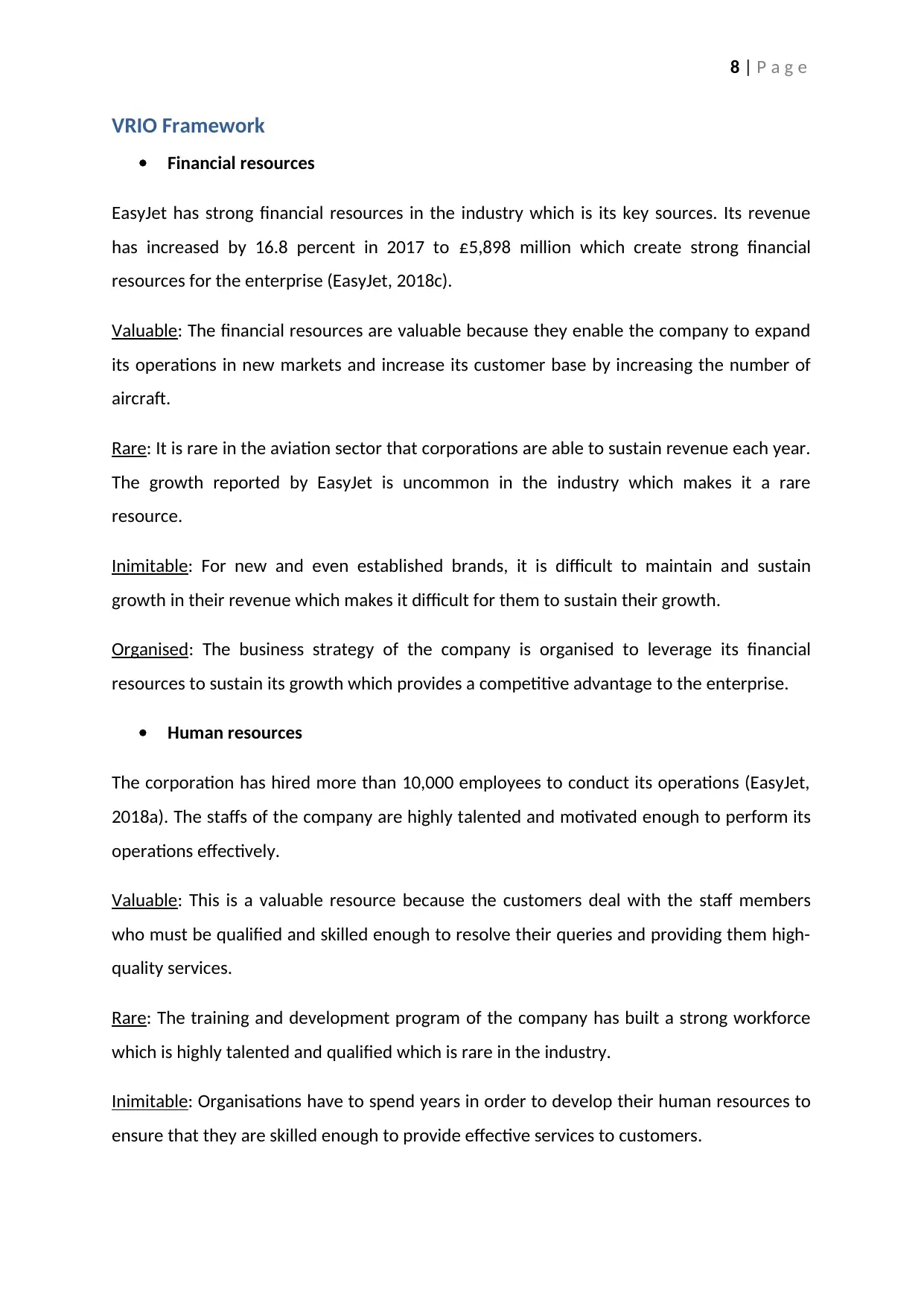
8 | P a g e
VRIO Framework
Financial resources
EasyJet has strong financial resources in the industry which is its key sources. Its revenue
has increased by 16.8 percent in 2017 to £5,898 million which create strong financial
resources for the enterprise (EasyJet, 2018c).
Valuable: The financial resources are valuable because they enable the company to expand
its operations in new markets and increase its customer base by increasing the number of
aircraft.
Rare: It is rare in the aviation sector that corporations are able to sustain revenue each year.
The growth reported by EasyJet is uncommon in the industry which makes it a rare
resource.
Inimitable: For new and even established brands, it is difficult to maintain and sustain
growth in their revenue which makes it difficult for them to sustain their growth.
Organised: The business strategy of the company is organised to leverage its financial
resources to sustain its growth which provides a competitive advantage to the enterprise.
Human resources
The corporation has hired more than 10,000 employees to conduct its operations (EasyJet,
2018a). The staffs of the company are highly talented and motivated enough to perform its
operations effectively.
Valuable: This is a valuable resource because the customers deal with the staff members
who must be qualified and skilled enough to resolve their queries and providing them high-
quality services.
Rare: The training and development program of the company has built a strong workforce
which is highly talented and qualified which is rare in the industry.
Inimitable: Organisations have to spend years in order to develop their human resources to
ensure that they are skilled enough to provide effective services to customers.
VRIO Framework
Financial resources
EasyJet has strong financial resources in the industry which is its key sources. Its revenue
has increased by 16.8 percent in 2017 to £5,898 million which create strong financial
resources for the enterprise (EasyJet, 2018c).
Valuable: The financial resources are valuable because they enable the company to expand
its operations in new markets and increase its customer base by increasing the number of
aircraft.
Rare: It is rare in the aviation sector that corporations are able to sustain revenue each year.
The growth reported by EasyJet is uncommon in the industry which makes it a rare
resource.
Inimitable: For new and even established brands, it is difficult to maintain and sustain
growth in their revenue which makes it difficult for them to sustain their growth.
Organised: The business strategy of the company is organised to leverage its financial
resources to sustain its growth which provides a competitive advantage to the enterprise.
Human resources
The corporation has hired more than 10,000 employees to conduct its operations (EasyJet,
2018a). The staffs of the company are highly talented and motivated enough to perform its
operations effectively.
Valuable: This is a valuable resource because the customers deal with the staff members
who must be qualified and skilled enough to resolve their queries and providing them high-
quality services.
Rare: The training and development program of the company has built a strong workforce
which is highly talented and qualified which is rare in the industry.
Inimitable: Organisations have to spend years in order to develop their human resources to
ensure that they are skilled enough to provide effective services to customers.
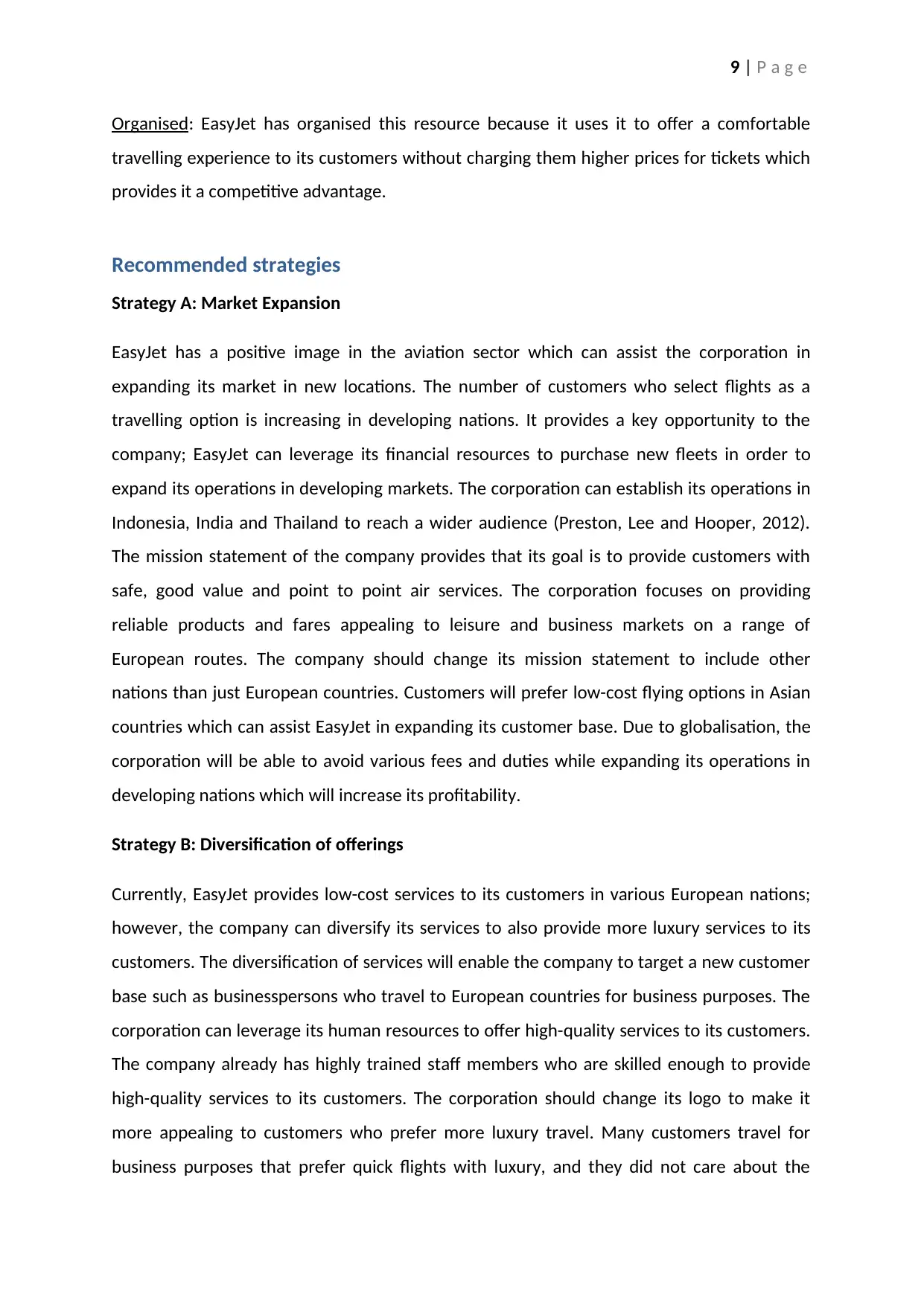
9 | P a g e
Organised: EasyJet has organised this resource because it uses it to offer a comfortable
travelling experience to its customers without charging them higher prices for tickets which
provides it a competitive advantage.
Recommended strategies
Strategy A: Market Expansion
EasyJet has a positive image in the aviation sector which can assist the corporation in
expanding its market in new locations. The number of customers who select flights as a
travelling option is increasing in developing nations. It provides a key opportunity to the
company; EasyJet can leverage its financial resources to purchase new fleets in order to
expand its operations in developing markets. The corporation can establish its operations in
Indonesia, India and Thailand to reach a wider audience (Preston, Lee and Hooper, 2012).
The mission statement of the company provides that its goal is to provide customers with
safe, good value and point to point air services. The corporation focuses on providing
reliable products and fares appealing to leisure and business markets on a range of
European routes. The company should change its mission statement to include other
nations than just European countries. Customers will prefer low-cost flying options in Asian
countries which can assist EasyJet in expanding its customer base. Due to globalisation, the
corporation will be able to avoid various fees and duties while expanding its operations in
developing nations which will increase its profitability.
Strategy B: Diversification of offerings
Currently, EasyJet provides low-cost services to its customers in various European nations;
however, the company can diversify its services to also provide more luxury services to its
customers. The diversification of services will enable the company to target a new customer
base such as businesspersons who travel to European countries for business purposes. The
corporation can leverage its human resources to offer high-quality services to its customers.
The company already has highly trained staff members who are skilled enough to provide
high-quality services to its customers. The corporation should change its logo to make it
more appealing to customers who prefer more luxury travel. Many customers travel for
business purposes that prefer quick flights with luxury, and they did not care about the
Organised: EasyJet has organised this resource because it uses it to offer a comfortable
travelling experience to its customers without charging them higher prices for tickets which
provides it a competitive advantage.
Recommended strategies
Strategy A: Market Expansion
EasyJet has a positive image in the aviation sector which can assist the corporation in
expanding its market in new locations. The number of customers who select flights as a
travelling option is increasing in developing nations. It provides a key opportunity to the
company; EasyJet can leverage its financial resources to purchase new fleets in order to
expand its operations in developing markets. The corporation can establish its operations in
Indonesia, India and Thailand to reach a wider audience (Preston, Lee and Hooper, 2012).
The mission statement of the company provides that its goal is to provide customers with
safe, good value and point to point air services. The corporation focuses on providing
reliable products and fares appealing to leisure and business markets on a range of
European routes. The company should change its mission statement to include other
nations than just European countries. Customers will prefer low-cost flying options in Asian
countries which can assist EasyJet in expanding its customer base. Due to globalisation, the
corporation will be able to avoid various fees and duties while expanding its operations in
developing nations which will increase its profitability.
Strategy B: Diversification of offerings
Currently, EasyJet provides low-cost services to its customers in various European nations;
however, the company can diversify its services to also provide more luxury services to its
customers. The diversification of services will enable the company to target a new customer
base such as businesspersons who travel to European countries for business purposes. The
corporation can leverage its human resources to offer high-quality services to its customers.
The company already has highly trained staff members who are skilled enough to provide
high-quality services to its customers. The corporation should change its logo to make it
more appealing to customers who prefer more luxury travel. Many customers travel for
business purposes that prefer quick flights with luxury, and they did not care about the
Secure Best Marks with AI Grader
Need help grading? Try our AI Grader for instant feedback on your assignments.

10 | P a g e
prices of the tickets (Wise, Muratori and Kyle, 2017). The company should target this
customer base to ensure that it is able to reach a new audience to increase its profitability.
The company can offer efficient services to its customers who wanted to travel to European
countries without wasting significant amount of time. This will open new opportunities for
the company to expand its offerings and increase its profitability.
SFA Analysis
The first strategy is more suitable based on SFA analysis through which the company will be
able to increase its customer base. This strategy is more suitable because the company can
leverage its financial resources to expand its business which will increase its profitability as
well. This strategy is more acceptable from the perspective of stakeholders because it will
enable the company to gain a competitive advantage over Ryanair in terms of number of
customers. This strategy is more feasible because the company already has financial
resources to comply with these plans. The corporation will be able to forecast its profits in
this strategy. Customers already have luxury flight options available which make it difficult
for the company to gain a competitive advantage through strategy B.
Key findings
Based on the above observations, EasyJet has generated a competitive advantage in the
aviation industry based on its cost-effective strategy. The company leverages its resources
to reach a wider audience who wanted to travel to European countries without spending
significant cost on travelling. The corporation can leverage its financial resources to expand
its business in new markets to ensure that it is able to sustain its growth in the aviation
industry.
Conclusion
In conclusion, EasyJet is a low-cost airline which offers cheaper flight options to its
customers. There are various political, social, technological and legal factors which affect the
operations of the company. The intensity in the aviation industry is high which creates
various challenges for the company. Two strategies are recommended in this report which
prices of the tickets (Wise, Muratori and Kyle, 2017). The company should target this
customer base to ensure that it is able to reach a new audience to increase its profitability.
The company can offer efficient services to its customers who wanted to travel to European
countries without wasting significant amount of time. This will open new opportunities for
the company to expand its offerings and increase its profitability.
SFA Analysis
The first strategy is more suitable based on SFA analysis through which the company will be
able to increase its customer base. This strategy is more suitable because the company can
leverage its financial resources to expand its business which will increase its profitability as
well. This strategy is more acceptable from the perspective of stakeholders because it will
enable the company to gain a competitive advantage over Ryanair in terms of number of
customers. This strategy is more feasible because the company already has financial
resources to comply with these plans. The corporation will be able to forecast its profits in
this strategy. Customers already have luxury flight options available which make it difficult
for the company to gain a competitive advantage through strategy B.
Key findings
Based on the above observations, EasyJet has generated a competitive advantage in the
aviation industry based on its cost-effective strategy. The company leverages its resources
to reach a wider audience who wanted to travel to European countries without spending
significant cost on travelling. The corporation can leverage its financial resources to expand
its business in new markets to ensure that it is able to sustain its growth in the aviation
industry.
Conclusion
In conclusion, EasyJet is a low-cost airline which offers cheaper flight options to its
customers. There are various political, social, technological and legal factors which affect the
operations of the company. The intensity in the aviation industry is high which creates
various challenges for the company. Two strategies are recommended in this report which
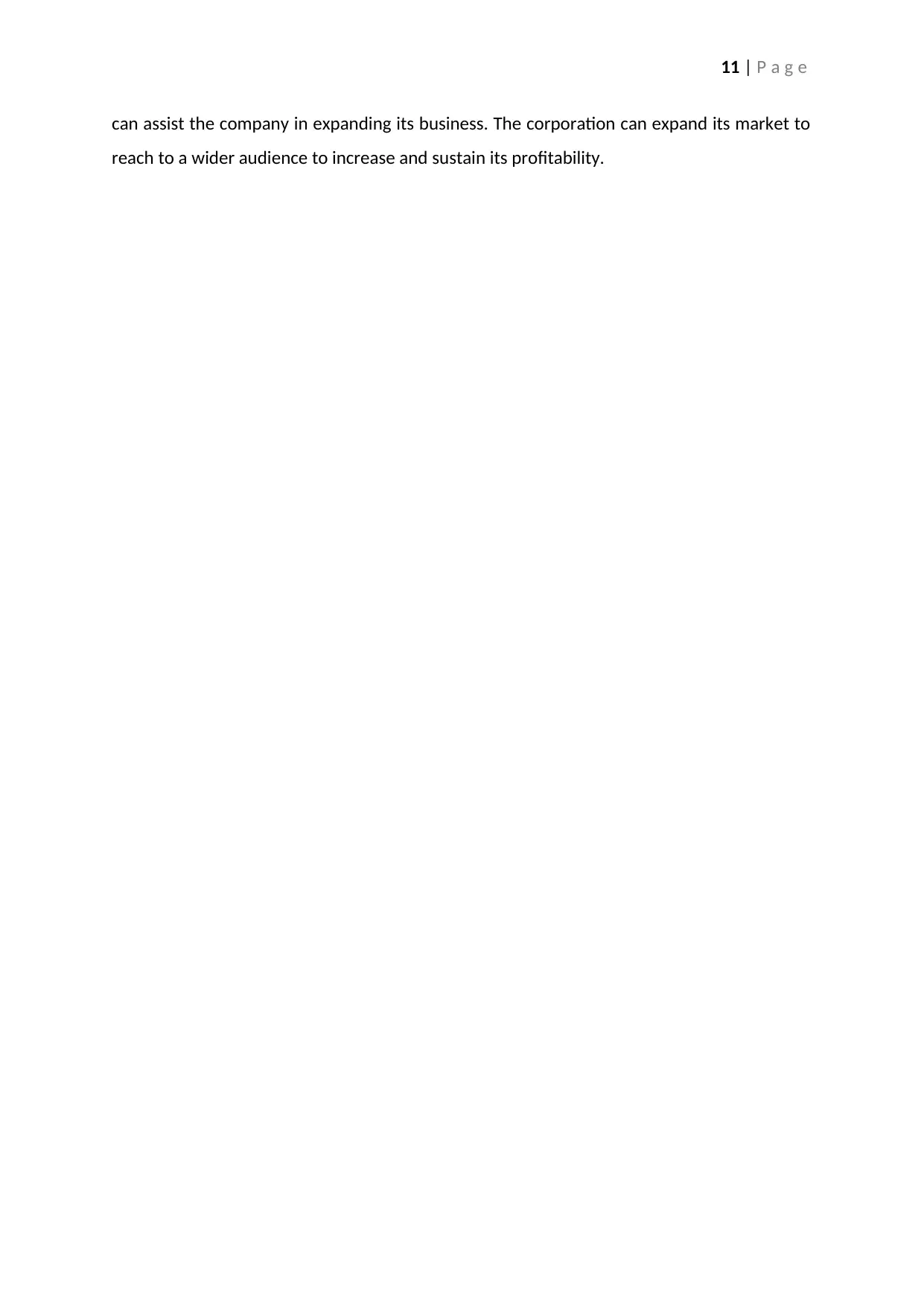
11 | P a g e
can assist the company in expanding its business. The corporation can expand its market to
reach to a wider audience to increase and sustain its profitability.
can assist the company in expanding its business. The corporation can expand its market to
reach to a wider audience to increase and sustain its profitability.
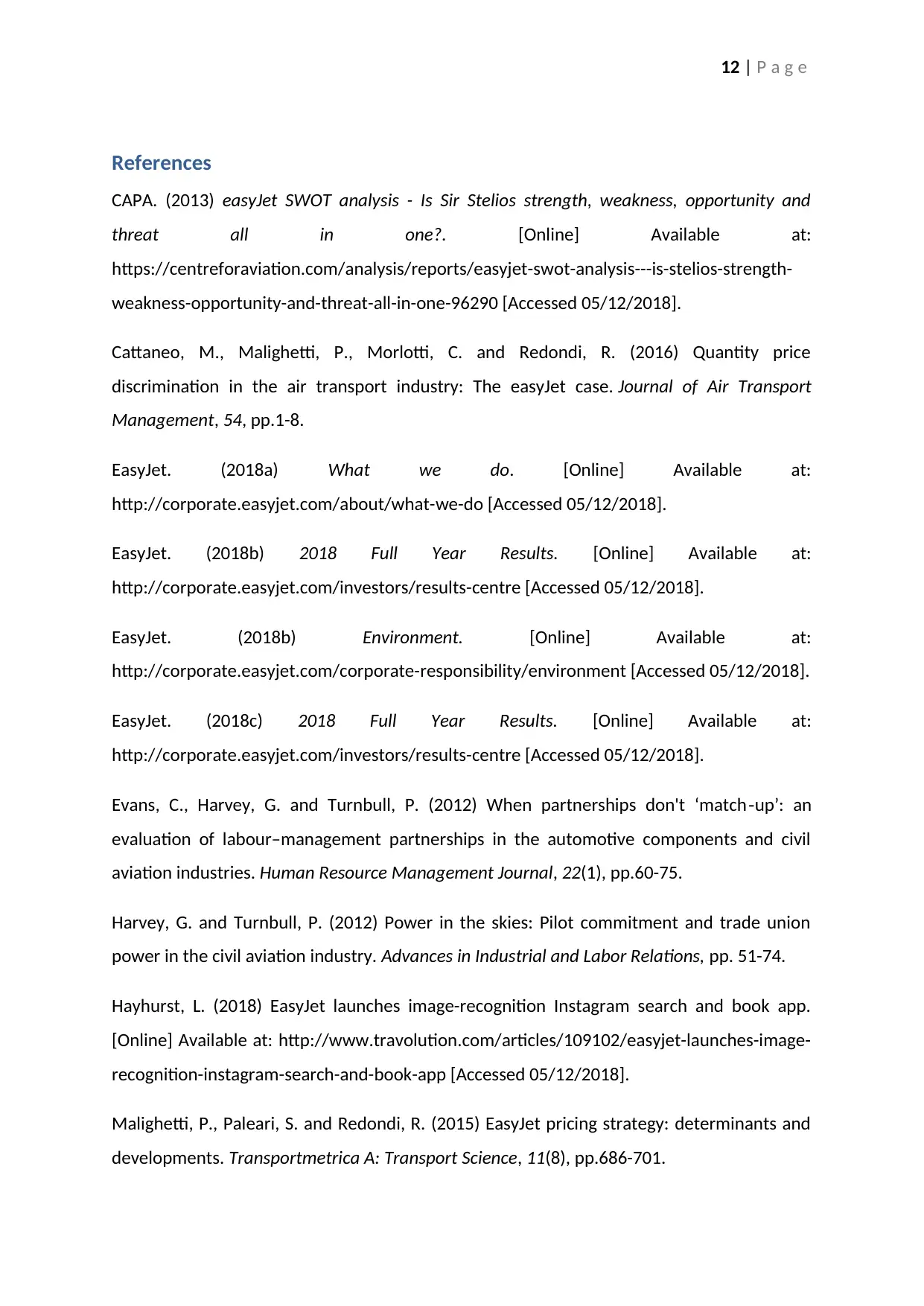
12 | P a g e
References
CAPA. (2013) easyJet SWOT analysis - Is Sir Stelios strength, weakness, opportunity and
threat all in one?. [Online] Available at:
https://centreforaviation.com/analysis/reports/easyjet-swot-analysis---is-stelios-strength-
weakness-opportunity-and-threat-all-in-one-96290 [Accessed 05/12/2018].
Cattaneo, M., Malighetti, P., Morlotti, C. and Redondi, R. (2016) Quantity price
discrimination in the air transport industry: The easyJet case. Journal of Air Transport
Management, 54, pp.1-8.
EasyJet. (2018a) What we do. [Online] Available at:
http://corporate.easyjet.com/about/what-we-do [Accessed 05/12/2018].
EasyJet. (2018b) 2018 Full Year Results. [Online] Available at:
http://corporate.easyjet.com/investors/results-centre [Accessed 05/12/2018].
EasyJet. (2018b) Environment. [Online] Available at:
http://corporate.easyjet.com/corporate-responsibility/environment [Accessed 05/12/2018].
EasyJet. (2018c) 2018 Full Year Results. [Online] Available at:
http://corporate.easyjet.com/investors/results-centre [Accessed 05/12/2018].
Evans, C., Harvey, G. and Turnbull, P. (2012) When partnerships don't ‘match‐up’: an
evaluation of labour–management partnerships in the automotive components and civil
aviation industries. Human Resource Management Journal, 22(1), pp.60-75.
Harvey, G. and Turnbull, P. (2012) Power in the skies: Pilot commitment and trade union
power in the civil aviation industry. Advances in Industrial and Labor Relations, pp. 51-74.
Hayhurst, L. (2018) EasyJet launches image-recognition Instagram search and book app.
[Online] Available at: http://www.travolution.com/articles/109102/easyjet-launches-image-
recognition-instagram-search-and-book-app [Accessed 05/12/2018].
Malighetti, P., Paleari, S. and Redondi, R. (2015) EasyJet pricing strategy: determinants and
developments. Transportmetrica A: Transport Science, 11(8), pp.686-701.
References
CAPA. (2013) easyJet SWOT analysis - Is Sir Stelios strength, weakness, opportunity and
threat all in one?. [Online] Available at:
https://centreforaviation.com/analysis/reports/easyjet-swot-analysis---is-stelios-strength-
weakness-opportunity-and-threat-all-in-one-96290 [Accessed 05/12/2018].
Cattaneo, M., Malighetti, P., Morlotti, C. and Redondi, R. (2016) Quantity price
discrimination in the air transport industry: The easyJet case. Journal of Air Transport
Management, 54, pp.1-8.
EasyJet. (2018a) What we do. [Online] Available at:
http://corporate.easyjet.com/about/what-we-do [Accessed 05/12/2018].
EasyJet. (2018b) 2018 Full Year Results. [Online] Available at:
http://corporate.easyjet.com/investors/results-centre [Accessed 05/12/2018].
EasyJet. (2018b) Environment. [Online] Available at:
http://corporate.easyjet.com/corporate-responsibility/environment [Accessed 05/12/2018].
EasyJet. (2018c) 2018 Full Year Results. [Online] Available at:
http://corporate.easyjet.com/investors/results-centre [Accessed 05/12/2018].
Evans, C., Harvey, G. and Turnbull, P. (2012) When partnerships don't ‘match‐up’: an
evaluation of labour–management partnerships in the automotive components and civil
aviation industries. Human Resource Management Journal, 22(1), pp.60-75.
Harvey, G. and Turnbull, P. (2012) Power in the skies: Pilot commitment and trade union
power in the civil aviation industry. Advances in Industrial and Labor Relations, pp. 51-74.
Hayhurst, L. (2018) EasyJet launches image-recognition Instagram search and book app.
[Online] Available at: http://www.travolution.com/articles/109102/easyjet-launches-image-
recognition-instagram-search-and-book-app [Accessed 05/12/2018].
Malighetti, P., Paleari, S. and Redondi, R. (2015) EasyJet pricing strategy: determinants and
developments. Transportmetrica A: Transport Science, 11(8), pp.686-701.
Paraphrase This Document
Need a fresh take? Get an instant paraphrase of this document with our AI Paraphraser

13 | P a g e
Morlotti, C., Cattaneo, M., Malighetti, P. and Redondi, R. (2017) Multi-dimensional price
elasticity for leisure and business destinations in the low-cost air transport market: Evidence
from easyJet. Tourism Management, 61, pp.23-34.
Pollak, S. (2018) Ryanair and Aer Lingus cancel flights this weekend. [Online] Available at:
https://www.irishtimes.com/news/consumer/ryanair-and-aer-lingus-cancel-flights-this-
weekend-1.3548379 [Accessed 05/12/2018].
Presse, A.F. (2017) French court fines easyJet over refusal to let disabled passenger board.
[Online] Available at: https://www.theguardian.com/business/2017/jan/20/french-court-
fines-easyjet-over-refusal-to-let-disabled-passenger-board [Accessed 05/12/2018].
Preston, H., Lee, D.S. and Hooper, P.D. (2012) The inclusion of the aviation sector within the
European Union's Emissions Trading Scheme: What are the prospects for a more sustainable
aviation industry?. Environmental Development, 2, pp.48-56.
Reuters. (2018) EasyJet PLC. [Online] Available at:
https://www.reuters.com/finance/stocks/companyProfile/EZJ.L [Accessed 05/12/2018].
Rogers, A. (2018) British Airways and Easyjet among airlines 'most exposed to a no-deal
Brexit'. [Online] Available at: http://www.cityam.com/263923/british-airways-and-easyjet-
among-airlines-most-exposed-no [Accessed 05/12/2018].
Santos-Vijande, M.L., López-Sánchez, J.Á. and Trespalacios, J.A. (2012) How organizational
learning affects a firm's flexibility, competitive strategy, and performance. Journal of
Business Research, 65(8), pp.1079-1089.
Shine, Z. (2016) EasyJet ordered to pay more than £10,000 over denied boarding. [Online]
Available at: https://www.telegraph.co.uk/travel/advice/easyjet-ordered-to-pay-10000-
over-denied-boarding/ [Accessed 05/12/2018].
Wise, M., Muratori, M. and Kyle, P. (2017) Biojet fuels and emissions mitigation in aviation:
An integrated assessment modeling analysis. Transportation Research Part D: Transport and
Environment, 52, pp.244-253.
Morlotti, C., Cattaneo, M., Malighetti, P. and Redondi, R. (2017) Multi-dimensional price
elasticity for leisure and business destinations in the low-cost air transport market: Evidence
from easyJet. Tourism Management, 61, pp.23-34.
Pollak, S. (2018) Ryanair and Aer Lingus cancel flights this weekend. [Online] Available at:
https://www.irishtimes.com/news/consumer/ryanair-and-aer-lingus-cancel-flights-this-
weekend-1.3548379 [Accessed 05/12/2018].
Presse, A.F. (2017) French court fines easyJet over refusal to let disabled passenger board.
[Online] Available at: https://www.theguardian.com/business/2017/jan/20/french-court-
fines-easyjet-over-refusal-to-let-disabled-passenger-board [Accessed 05/12/2018].
Preston, H., Lee, D.S. and Hooper, P.D. (2012) The inclusion of the aviation sector within the
European Union's Emissions Trading Scheme: What are the prospects for a more sustainable
aviation industry?. Environmental Development, 2, pp.48-56.
Reuters. (2018) EasyJet PLC. [Online] Available at:
https://www.reuters.com/finance/stocks/companyProfile/EZJ.L [Accessed 05/12/2018].
Rogers, A. (2018) British Airways and Easyjet among airlines 'most exposed to a no-deal
Brexit'. [Online] Available at: http://www.cityam.com/263923/british-airways-and-easyjet-
among-airlines-most-exposed-no [Accessed 05/12/2018].
Santos-Vijande, M.L., López-Sánchez, J.Á. and Trespalacios, J.A. (2012) How organizational
learning affects a firm's flexibility, competitive strategy, and performance. Journal of
Business Research, 65(8), pp.1079-1089.
Shine, Z. (2016) EasyJet ordered to pay more than £10,000 over denied boarding. [Online]
Available at: https://www.telegraph.co.uk/travel/advice/easyjet-ordered-to-pay-10000-
over-denied-boarding/ [Accessed 05/12/2018].
Wise, M., Muratori, M. and Kyle, P. (2017) Biojet fuels and emissions mitigation in aviation:
An integrated assessment modeling analysis. Transportation Research Part D: Transport and
Environment, 52, pp.244-253.
1 out of 14
Related Documents
Your All-in-One AI-Powered Toolkit for Academic Success.
+13062052269
info@desklib.com
Available 24*7 on WhatsApp / Email
![[object Object]](/_next/static/media/star-bottom.7253800d.svg)
Unlock your academic potential
© 2024 | Zucol Services PVT LTD | All rights reserved.





